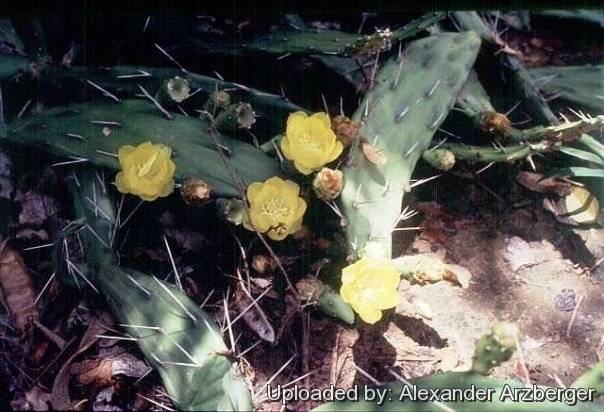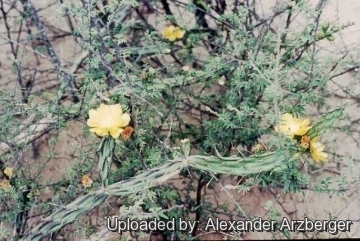Accepted Scientific Name: Opuntia anacantha var. retrorsa (Speg.) R.Kiesling
Candollea 53: 475. 1998

Opuntia retrorsa (Opuntia anacantha var. retrorsa) Photo by: Alexander Arzberger
Origin and Habitat: Northern Argentina. It is also present in Brazil (Mato Grosso do Sul), southern lowland Bolivia, Uruguay, and Paraguay.
Type locality: Territory of the Chaco, Argentina.
Habitat and ecology. Opuntia anacanthaSN|28385]]SN|28385]] var. retrorsa is often found on dry dune in the Chaco regions but also in the humid-Subhumid (or Eastern) Chaco woodland. Cacti such as: Cleistocactus baumanniiSN|4742]]SN|4742]], Echinopsis rhodotrichaSN|21017]]SN|21017]], Harrisia balansaeSN|7296]]SN|8108]], Harrisia tortuosaSN|8108]]SN|7296]], and Stetsonia coryneSN|19128]]SN|19128]] are an important feature of these woodlands. At field level common herbaceous species are Aechmea distachantha, Dyckia ferox and various grasses.
Synonyms:
See all synonyms of Opuntia anacantha
Common Names include:
SPANISH (Español): tuna
Description: Opuntia anacantha var. retrorsa, (Opuntia retrorsaSN|33077]]SN|28390]]), is a jointed shrubby cactus, usually decumbent and rooting along the under surface, sometimes ascending and clambering, forming low clumps to 60 cm high and 2.5 m wide. The joints are typically with sharp spines turned backward and has violet stripes downwards from the areoles. It is one of the morphological or local forms of the very variable Opuntia anacantha (typically unarmed), and the two plants are not readily distinguishable, if not for the presence of spines. More likely they are one and the same species. Opuntia anacanthaSN|28385]]SN|28385]] presents a large morphological variability and has a large distribution area.
Derivation of specific name: 'retrorsa' Opuntia anacanthaSN'>28385]SN|28385]] var. retrorsa, occurring in Argentina, is quite similar to the Bolivian Opuntia fuscolineata, but O. fuscolineata has dark brown stripes downwards from the areoles (not violet), fewer and shorter spines, which are only 2.5 cm long, and in older areoles only additionally 1–3 minor spines about 1 cm long. It has also smaller flowers (about 3 cm in diameter). There is another species with purplish stripes below the areoles in the adjacent region: Opuntia paraguayensisSN|28390]]SN|33077]]. However, the stem segments in this opuntia are much wider (5–8.5cm), spines are usually absent (occasionally one yellowish), and the flowers are much bigger (to 8 cm) and orange.
Subspecies, varieties, forms and cultivars of plants belonging to the Opuntia anacantha group
- Opuntia anacantha Speg.: (var. anacantha) has dark green stem segments usually spineless and yellow flowers. Distribution: Southern Gran Chaco region of Argentina.
 Opuntia anacantha var. kiska-loro (Speg.) R.Kiesling: has light green stem segments and orange flowers. Distribution: far north of Argentina into Bolivia.
Opuntia anacantha var. kiska-loro (Speg.) R.Kiesling: has light green stem segments and orange flowers. Distribution: far north of Argentina into Bolivia.  Opuntia anacantha var. retrorsa (Speg.) R.Kiesling: has light green stem segments with sharp spines turned backward and has violet stripes downwards from the areoles. Flowers are yellow. Distribution: grassland in southern part of the range, Argentina.
Opuntia anacantha var. retrorsa (Speg.) R.Kiesling: has light green stem segments with sharp spines turned backward and has violet stripes downwards from the areoles. Flowers are yellow. Distribution: grassland in southern part of the range, Argentina.- Opuntia anacantha var. utkilio (Speg.) R.Kiesling: has elliptical, green stem segments and yellow flowers. Distribution: near Tucuman, Argentina.
Bibliography: Major references and further lectures
1) N. L. Britton, J. N. Rose: “The Cactaceae. Descriptions and Illustrations of Plants of the Cactus Family.” Vol I, The Carnegie Institution of Washington, Washington 1919
2) Felix Faustino Outes, Fernando Lahille, Museo Argentino de Ciencias Naturales "Anales del Museo Nacional de Ciencias NaturalesBernardino Rivadavia" Juan A. Alsina, 1905
3) Gomes, Vanessa G.N.; Araújo, Andréa C. “Cacti species from the Brazilian Chaco: floral and fruit traits” in: Gaia Scientia v. 9, n. 2 (2015)
4) Walter Starmühler & Walter Mucher sen. “Two new Opuntia species (Cactaceae) from Bolivia and Argentina” in: Wulfenia - Mitteilungen des Kärntner Botanikzentrums Klagenfurt 12 (2005): 57–63
5) Peter Martin Rhind “Plant Formations in the Chacoan and South Andean Yungas BioProvince” <http://terrestrial-biozones.net/Neotropic%20Vegetation/Chacoan%20Vegetation.pdf>
6) Anderson, E. F. “The cactus family” 2001
7) Hunt, D., Taylor, N. and Charles, G. “The New Cactus Lexicon.” dh Books, Milborne Port, UK. 2006
 Flowers on an almost completely dehydrated plant. Sometimes Opuntia retrorsa begins to bloom in November even without rain. (Opuntia anacantha var. retrorsa) Photo by: Alexander Arzberger
Flowers on an almost completely dehydrated plant. Sometimes Opuntia retrorsa begins to bloom in November even without rain. (Opuntia anacantha var. retrorsa) Photo by: Alexander ArzbergerSend a photo of this plant.The gallery now contains thousands of pictures, however it is possible to do even more. We are, of course, seeking photos of species not yet shown in the gallery but not only that, we are also looking for better pictures than those already present.
Read More... Cultivation and Propagation: Opuntia anacanthaSN|28390]]SN|28385]] var. retrorsa, (Opuntia retrorsaSN|28385]]SN|28390]]) is a a much decorative cactus not very common in cultivation. It is a summer grower species that offers no cultivation difficulties.
Soil: Use a very a particularly draining substratum, as it is sensitive to rottenness when in presence of humidity and low temperatures and let the soil dry out between waterings, since it's natural habitat is in sandy or gravelly, well draining soils.
Repotting: Repot in the spring, when their roots become cramped. Generally, they should be repotted every other year in order to provide fresh soil. After repotting, do not water for a week or more.
Water: In summer, during the vegetative period, it must be regularly watered, but allowing the substratum to completely dry up before irrigating again (but do not overwater ); in winter, it’s to be kept dry. Preferable not to water on overcast days, humid days or cold winter days.
Hardiness: It is a quite frost resistant cactus, hardy to -7° C. However in cultivation it is better not to expose it to temperatures lower than -0° C, even if in an aerated and protected location, in order to avoid the formation of anti-aesthetic spots on the epidermis. In presence of high atmospheric humidity avoid any frost as it is particularly sensitive to root rot. USDA Zone 7-10. It can handle extremely high temperatures in summer.
Exposure: Outside full sun or afternoon shade, inside needs bright light, and some direct sun.
Use: It is suitable for “desert” gardens, in association with other xerophytes. Where the open air cultivation is not possible due to the climate, it is to be cultivated in pot in order to shelter it in winter.
Warning: It is armed with treacherous spines that are extremely sharp. Handle it with caution, and keep it away from gangways and areas frequented by children and animals. Spines must be meticulously removed with tweezers.
Propagation: Stem division. Prickly pear pads root easily and grow rapidly when placed in loose, well-draining soil.











